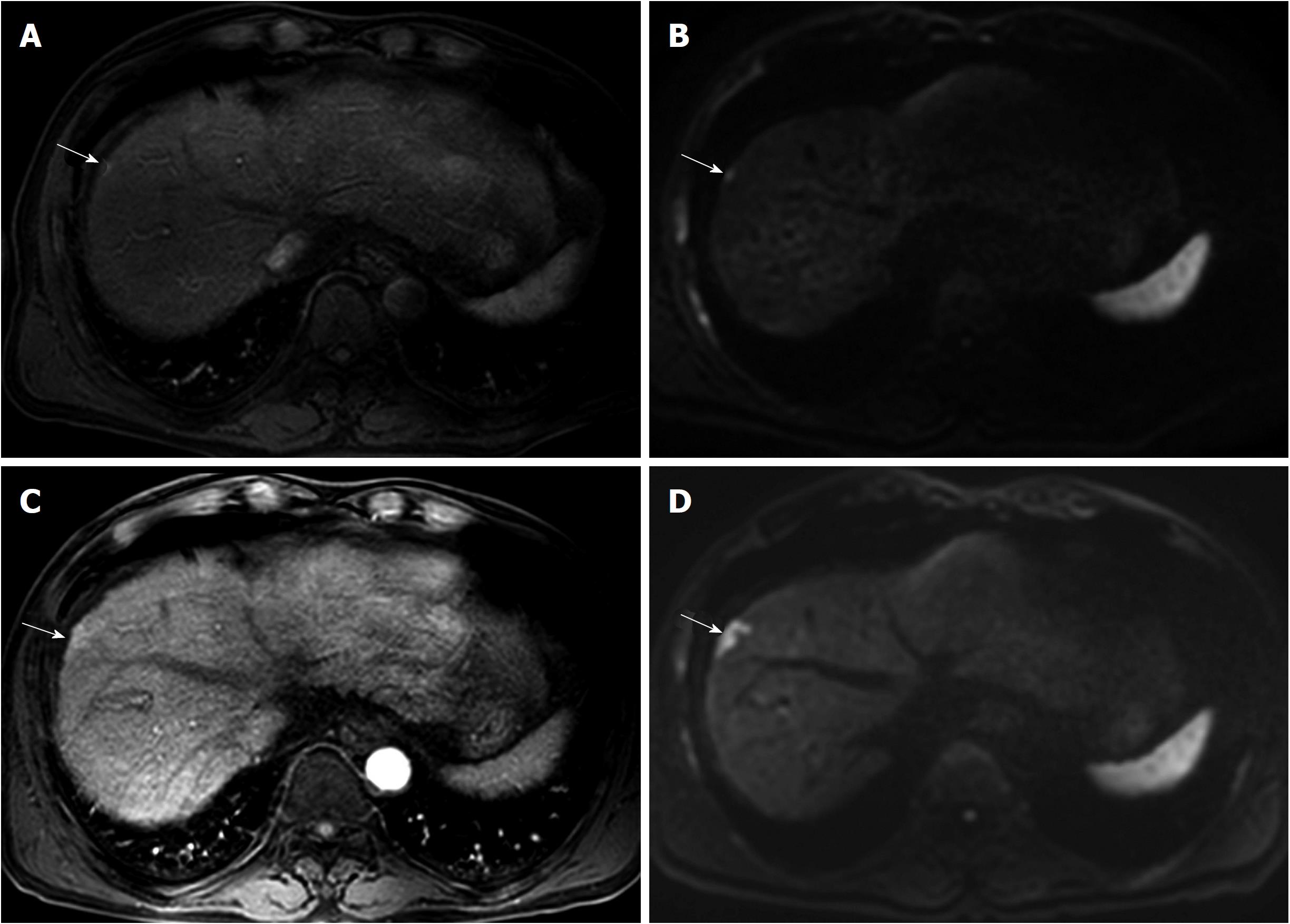Copyright
©The Author(s) 2018.
World J Gastroenterol. Dec 14, 2018; 24(46): 5215-5222
Published online Dec 14, 2018. doi: 10.3748/wjg.v24.i46.5215
Published online Dec 14, 2018. doi: 10.3748/wjg.v24.i46.5215
Figure 1 45-year-old man with a history of left hemihepatectomy for hepatocellular carcinoma.
A 6-mm recurrent hepatocellular carcinoma (HCC) in segment 5 of the liver is seen on magnetic resonance imaging. The nodule (arrow) shows arterial enhancement (A), washout on transitional phase (B), high signal intensity on both T2- and diffusion-weighted images (C and D), and low signal intensity on hepatobiliary phase (E). On planning ultrasound (US) with fusion imaging (F), the nodule was invisible using real-time US image (left figure) at the corresponding site of the fused magnetic resonance image (right figure). When contrast-enhanced ultrasound (CEUS) using Sonazoid (GE Healthcare, Oslo, Norway) was added to fusion imaging, there was a nodule (arrow) with arterial enhancement (G) and low echogenicity in the post-vascular phase (H). Under CEUS-added fusion imaging guidance (I), the radiofrequency (RF) electrode was accurately placed through the tumor (arrow). At follow up computed tomography obtained immediately after RF ablation (J), the index tumor was completely ablated with sufficient ablative margin (arrowhead).
Figure 2 78-year-old man with a history of radiofrequency ablation for hepatocellular carcinoma.
A 6-mm enhancing nodule in segment 6 of the liver is seen on magnetic resonance imaging (MRI). Although the nodular lesion (arrow) shows arterial enhancement (A), it did not show washout on transitional phase (B). The lesion shows high signal intensity on both T2- and diffusion-weighted images (C and D), and low signal intensity on hepatobiliary phase (E). As the lesion did not show typical imaging features of hepatocellular carcinoma (HCC), the patient was followed with MRI. At follow up MRI obtained 3 mo later, the lesion disappeared (now shown here), suggesting the lesion was not HCC.
Figure 3 61-year-old man with a history of transarterial chemoembolization for hepatocellular carcinoma.
A 6-mm recurrent hepatocellular carcinoma in segment 8 of the liver is seen by magnetic resonance imaging (MRI). The tiny nodule (arrow) shows arterial enhancement (A) and high signal intensity on diffusion-weighted image (B). Unfortunately, there was no mention of the lesion in the radiologic report, and the tumor was unintentionally diagnosed late. At follow up MRI obtained 6 mo later, the lesion (arrow) had increased in size and measured up to 22 mm on arterial phase (C) and diffusion-weighted image (D). Given that the lesion had irregular margins and showed rapid growth, the tumor might have aggressive tumor biology.
- Citation: Lee MW, Lim HK. Management of sub-centimeter recurrent hepatocellular carcinoma after curative treatment: Current status and future. World J Gastroenterol 2018; 24(46): 5215-5222
- URL: https://www.wjgnet.com/1007-9327/full/v24/i46/5215.htm
- DOI: https://dx.doi.org/10.3748/wjg.v24.i46.5215











